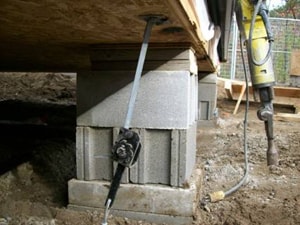THE ANCHORING PRINCIPLE

Soil Test Methods
Soil resistance to anchor driving is a good indication of soil type. Softer soil is indicated by less resistance, in which case the anchor would be placed deeper to achieve maximum strength.
Torque Probe Readings
For specific data on soil classification, a Soil Test Probe provides a simple means of measuring sub-soil values without core samples. A ratchet handle torque wrench, which slides up and down the probe shaft, is used to install and retract the probe. Torque wrench readings, in inch-pounds, provide a way to measure the consistency of the sub-soil. Torque values translate into soil classifications and, multiple measurements can be made at as many required depths.
Frame Tie Downs
The number of ties required to secure a mobile home depend on a number of variables. The length, the shape of the unit, wind, speed and direction. As well as the type of connection between the unit and its steel supporting frame.
Concrete blocks tend to break and chip, but our Leveling Jacks will provide the proper support to keep your load stable.
